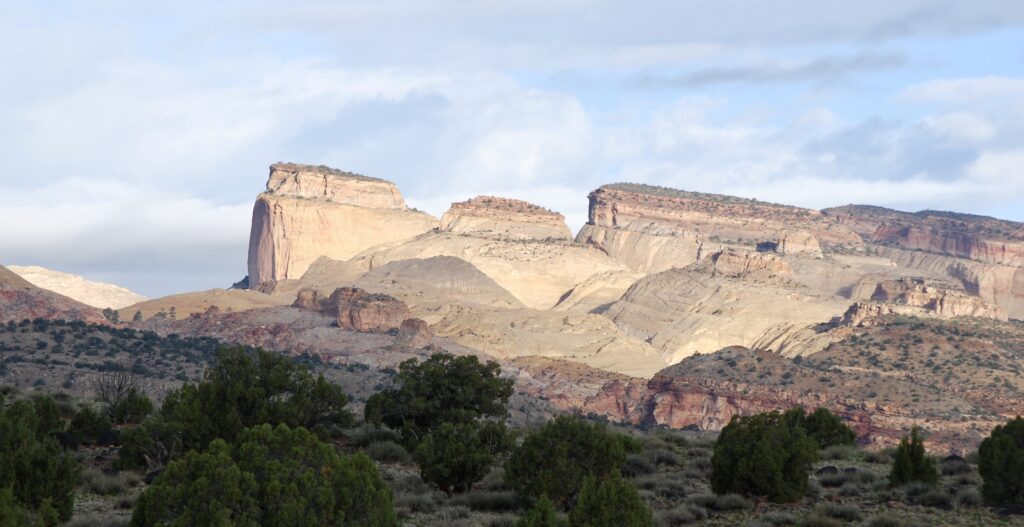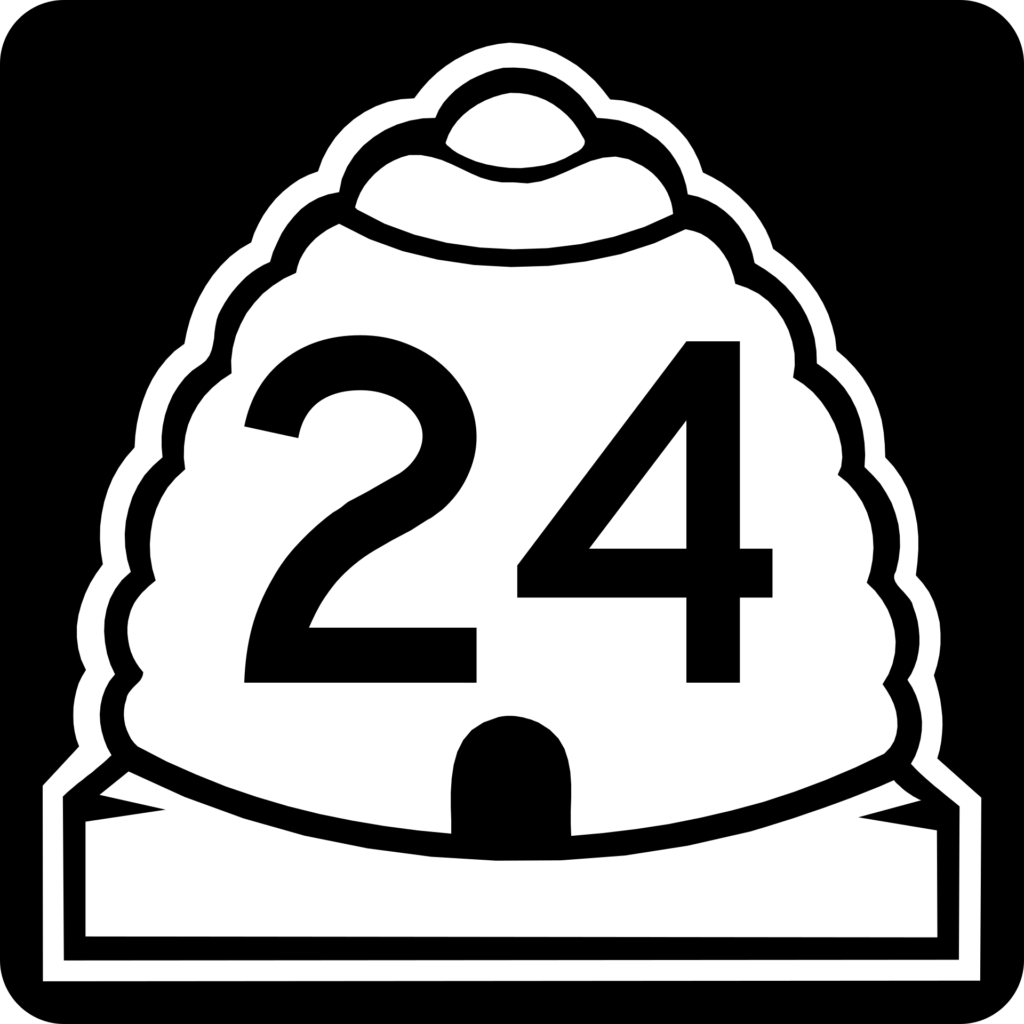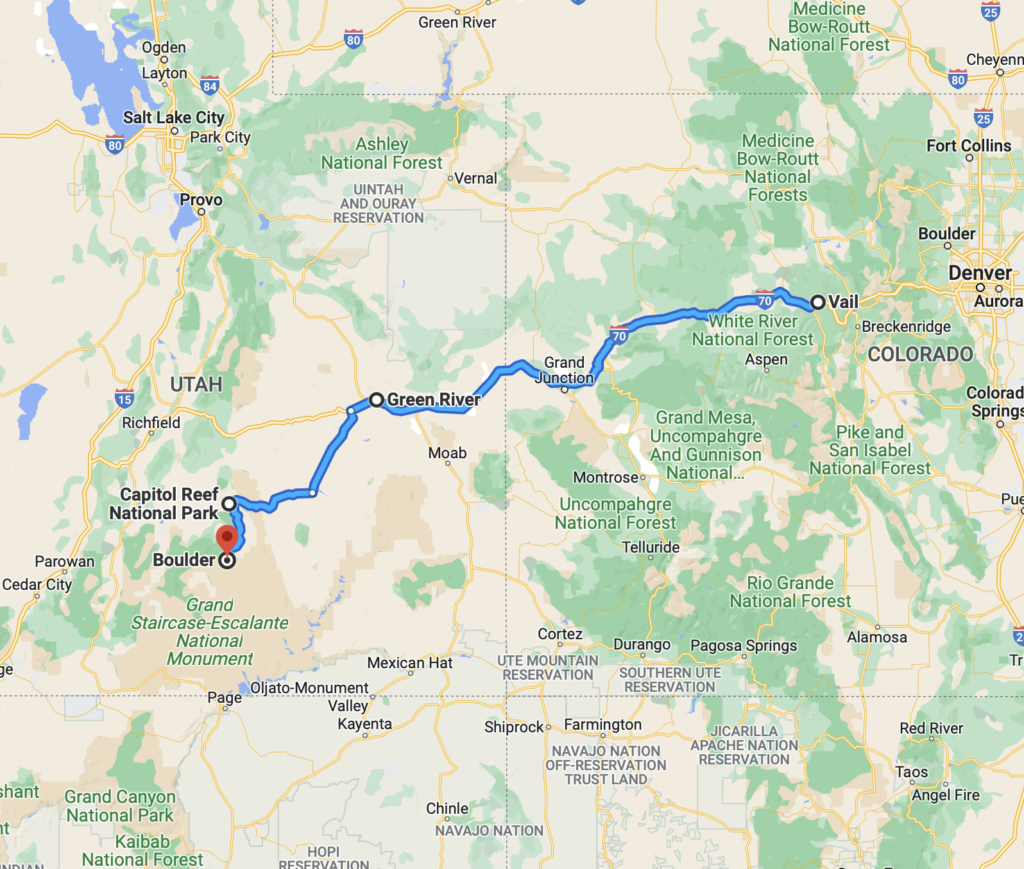Day One: I-70 to Green River; Utah 24 to Torrey; Utah 12 to Boulder.

This is the second in a series of dispatches from Clay Jenkinson chronicling his recent journey with two compatriots following the Colorado River and neighboring region. Travel day one, the trip begins in Vail, Colorado, headed southeast through Capitol Reef National Park and then over the Aquarius Plateau in southern Utah. The two-week expedition explored the state of water, or the absence of it, in the West.
Dennis and I left Vail, Colorado, at 9:30 a.m. We drove Interstate 70 to Grand Junction, where Dennis wanted some healthy groceries. I’m from North Dakota — the land of Velveeta — so I am just along for the ride. Dennis and I have known each other for 25 years and our life dreams have found their confluence in Listening to America. If you want conversation that is serious, intentional, nuanced, and gets to the heart of things without getting ponderous, Dennis McKenna is your man.

I-70 west of Denver is not dreary and utilitarian like most of the Interstate system in America. The stretch through Glenwood Canyon (through which the Colorado River flows) is one of the most beautiful highways in America — elegant, elongated s-curves of concrete on graceful stilts, the powerful river storming through the canyon on the left, impossibly beautiful views of geological chaos, a triumph — rare in the 1970s — of aesthetically compelling engineering. A triumph of style over dynamite. The driver of the vehicle is at a disadvantage because he must pay attention to the road, and the poor shotgun guy is snapping away with his camera not like Ansel Adams or Edward S. Curtis but just to record the magnificence of the canyon to jog the memory later.
I-70 picks up the Colorado River at Dotsero, west of Vail and Edwards, coming down from its source high up in Rocky Mountain National Park. Dotsero has a population of 950. I always light up when I cross the I-70 bridge there and see the Colorado River for the first time. It is a considerable mountain stream by this point, but it is hard to believe that this is the great contested river that fills (or attempts to fill) 15 reservoirs, including two of the giants, behind Glen Canyon and Hoover dams. There are three finalists for the prize of “most industrialized river of America” — the Missouri, the Columbia, and the Colorado. Of the three — all tamed by concrete nearly beyond recognition — only the Colorado gets literally used up before it reaches its mouth. The Missouri delivers millions of acre feet into the Mississippi at St. Charles, near St. Louis, and the Columbia’s flow at Astoria is beyond comprehension. But way down in the Gulf of California, the flow of what’s left of the Colorado amounts to little more than moist sand and seepage.
Up here not 150 miles from its source, the Colorado River is all promise. It’s as clear as any mountain stream. Sometime after we drove through the town of Rifle the river suddenly turned brown and red and now it was recognizable as the fabled Colorado. The shift from clear to turbid happened so suddenly that both of us exclaimed at the same time.

We were in a hurry to get to Boulder, Utah, where Dennis lives so we spent just a quick hour at the John Wesley Powell River History Museum at Green River, Utah. We’d both been there before several times, but you can never get enough of Major Powell, one of my heroes, the one-armed Civil War veteran who floated the Green and Colorado rivers in 1869. It’s a great museum, except for the orientation film and the animatron with the big “frontier” voice. The orientation film belongs to the old Wilford Brimley and William Conrad era of documentaries with the faux western voice that registers somewhere between Festus and Walter Brennan. A voice never used in real life by anyone, ever, and yet standard when we try to recreate the feel of the frontier. The orientation film deserves a remake, with more emphasis on Native Americans and environmental concerns. The robot is popular with children, so maybe if they just turn the volume down a little. The “Hey, pardner what brung you to these here parts” stuff is a little disconcerting. John Wesley Powell was mostly an autodidact but he was one of the most thoughtful men ever to explore the West and he was equally at home around a Northern Paiute campfire or a Congressional subcommittee.
The museum has an excellent vertical statue group of Powell and his colleagues on the river, with outstanding bas reliefs of scenes from the 1869 adventure. The signage throughout the interpretive center is uniformly accurate and insightful. We bought books, of course. The shop has one of the better western book selections in the country. The Green River, just west of the museum, is unimpressive here. But give it time downstream.

Once we left the freeway and descended into the heart of southern Utah, we went mostly silent, filled with awe. I suppose if you live there long enough you could come to take it for granted, the way people who live in the flight path near airports learn to tune out the industrial roar. But there is no place quite like it in the United States or the world for that matter. My nose is pressed to the windshield. I want to move through the scene at three miles per hour, like the people of Powell’s time.

On the way to Boulder, we drove through a section of Capitol Reef National Park. Dennis explained the presence of hundreds of fruit trees in the park, many heirloom varieties and part of a historic settlement called Fruita, inside the Park. Today, visitors are permitted to come in season and harvest a couple of bushels for home use. Sometimes we forget that the National Parks are dedicated to conserving the cultural heritage, the built environment, within their boundaries, too. An inholding here, an original strand of barbed wire there, a crude chapel built of loose stones — such things are also what a National Park exists to commemorate and protect.
We stopped at a giant cottonwood tree. Bare. No buds yet. It was easily the largest cottonwood tree I have ever seen. Just as the pronghorn antelope is my Great Plains fetish animal, so the cottonwood is my favorite plains tree. Every year I spend as many days lying under a rustling cottonwood as I can squeeze out of my schedule. If Dennis and I had tried to hug the tree, we two would have been three persons short of a closed circle of hands. I so want to be back at that tree when it has fully bloomed but when the leaves are still delicate and nearly translucent; and again, when the leaves all turn yellow golden in late September. What must such a tree drink per day from that seemingly dry wash? How old must this tree be? Hundreds of years, I think.
We reached our destination well before dusk.

Editor’s Note: You can track Clay’s dispatches on this Colorado River Journey by following the links from his route and itinerary below. You can also keep up with all LTA’s dispatches, essays, photos, and podcasts on this topic through the tab “Water in the West.” This is one of many ongoing road trips at the heart of Listening to America. Our mission is to “light out for the territories,” traveling less visited byways and taking time to see this immense, extraordinary country with fresh eyes while listening to the many voices of America’s past, present, and future.
Water in the West — Routes and Itinerary
- Introduction: A Colorado River Journey, The Trek Begins.
- Day One, Friday: I-70 Vail to Green River; Utah 24 to Torrey; Utah 12 to Boulder, Utah.
- Day Two, Saturday: Boulder, Utah.
- Day Three, Sunday: Utah 12 to Torrey; Utah 24 to Hanksville; Utah 95 to Natural Bridges National Monument; Utah 261 to Mexican Hat; U.S. 163 to Bluff; Utah 162 to Aneth; Indian Route 5068/Arizona County Road G to Cortez.
- Day Four, Monday: Crow Canyon Archaeological Center, Cortez, Colorado.
- Day Five, Tuesday: Colorado 160/491 to Chimney Rock; Colorado 160 to Teec Nos Pos; Colorado 160 to Mexican Water; U.S. 191 Tsaile; Arizona 64 to Chinle.
- Day Six, Wednesday: Canyon de Chelly; U.S. 191 to Burnside; Arizona 264 to Second Mesa.
- Day Seven, Thursday: Hopi Cultural Center; Arizona 264 to Tuba City; U.S. 160 to U.S. 89; U.S. 89 to Bitter Springs; U.S. 89A to Marble Canyon.
- Day Eight, Friday: U.S. 89A to Bitter Springs; U.S. 89 to Page, Arizona.
- Day Nine, Saturday: Lake Powell; U.S. 89 to Kanab.
- Days 10 & 11, Sunday/Monday: U.S. 89 to Utah 20; Utah 20 to I-15; I-15 to Salt Lake City.
- Days 12 & 13, Tuesday/Wednesday: Salt Lake City.
- Reflections on A Colorado River Journey.
